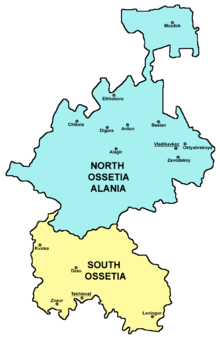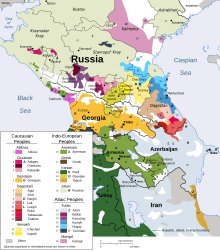43°N 44°E / 43°N 44°E / 43; 44

Ossetia (/ɒˈsɛtiə/ o-SET-ee-ə, less common: /ɒˈsiːʃə/ o-SEE-shə; Ossetian: Ирыстон or Ир, romanized: Iryston or Ir, pronounced [iˈrəston]) is an ethnolinguistic region located on both sides of the Greater Caucasus Mountains, largely inhabited by the Ossetians. The Ossetian language is part of the Eastern Iranian branch of the family of Indo-European languages. Most countries recognize the Ossetian-speaking area south of the main Caucasus ridge as lying within the borders of Georgia, but it has come under the control of the de facto government of the Russian-backed Republic of South Ossetia – the State of Alania. The northern portion of the region consists of the, Republic of North Ossetia-Alania within the Russian Federation.
Recent history
For earlier history, see Alans and Sarmatians. See also: History of South Ossetia and History of North Ossetia–Alania

- 1774 – Expansion of the Russian Empire on Ossetian territory.
- 1922 – Creation of the South Ossetian autonomous oblast. North Ossetia remains a part of Russian SFSR, South Ossetia remains a part of Georgian SSR.
- 20 September 1990 – South Ossetia declares independence. The republic remained unrecognized, yet it detached itself from Georgia de facto. In the last years of the Soviet Union, ethnic tensions between Ossetians and Georgians in Georgia's former Autonomous Oblast of South Ossetia (abolished in 1990) and between Ossetians and the Ingush in North Ossetia evolved into violent clashes that left several hundred dead and wounded and created a large tide of refugees on both sides.
Although a Russian-mediated and Organization for Security and Co-operation in Europe-monitored ceasefire was implemented in South Ossetia in 1992, the Georgian-Ossetian conflict still remains unresolved even though a recent peace plan proposed by the government of Georgia promised the South Ossetians larger autonomy and pledged expanded international involvement in the political settlement of the conflict. Meanwhile, the South Ossetian secessionist authorities demand independence or unification with North Ossetia, which itself is located in Russia, while the international community instead recognizes it and Abkhazia as a part of Georgia.
On Sunday 12 November 2006, South Ossetians (mostly ethnic Ossetians) went to the polls to vote in a referendum regarding the region's independence from Georgia. The result was a "yes" to independence, with a turnout above 95% from those among the territory's 70,000 people who were eligible to vote at that time. There was also a vote in favor of a new term for Eduard Kokoity, who was the de facto state's president at the time.
There have been proposals from South Ossetia for joining the Russian Federation and uniting with North Ossetia.
See also
- History of North Ossetia–Alania
- Alania
- Vladimir Gagloyev
- Jászság
- Alexander Kubalov
- Samachablo
- Circassia
- Iazyges
- Adygea
References
- Foltz, Richard (2022). The Ossetes: Modern-Day Scythians of the Caucasus. London: Bloomsbury. p. 1. ISBN 978-0755618453.
- Group, International Crisis (2010). "Appendix B: Map of South Ossetia". South Ossetia: 25. JSTOR resrep37032.11.
{{cite journal}}:|last=has generic name (help) - Stepanova, Ekaterina (2008). "South Ossetia and Abkhazia: Placing the Conflict in Context". Stockholm International Peace Research Institute. JSTOR resrep19160.
{{cite journal}}: Cite journal requires|journal=(help) - Manutscharjan, Aschot (2008). "Abkhazia and South Ossetia – Russia's Intervention in Georgia (August 2008)". Konrad Adenauer Stiftung.
{{cite journal}}: Cite journal requires|journal=(help) - Markedonov, Sergey (2015), Bebler, Anton (ed.), "The South Ossetia conflict", 'Frozen conflicts' in Europe (1st ed.), Verlag Barbara Budrich, pp. 111–118, ISBN 978-3847401339, JSTOR j.ctvdf0bmg.11, retrieved 16 March 2022
- "Archived copy". Archived from the original on 5 February 2017. Retrieved 4 February 2017.
{{cite web}}: CS1 maint: archived copy as title (link) - http://s50.radikal.ru/i129/1003/22/2fec9d793e3d.jpg Archived 8 June 2020 at the Wayback Machine
- Sokirianskaia (PDF), HU: CEU.
- "South Ossetia profile". BBC News. 21 April 2016. Retrieved 25 September 2020.
- Refugees, United Nations High Commissioner for. "World Directory of Minorities and Indigenous Peoples – South Ossetia (unrecognized state)". Refworld. Retrieved 16 March 2022.
- Ghebali (2003), Helsinki (PDF), vol. 4, CH
{{citation}}: CS1 maint: location missing publisher (link). - Avrasya (2005), Ehatipoglu (PDF), TR: Obiv
- Souleimanov, Emil (2013). Understanding ethnopolitical conflict : Karabakh, South Ossetia, and Abkhazia wars reconsidered. Houndmills, Basingstoke, Hampshire. ISBN 978-1137280237. OCLC 855585455.
{{cite book}}: CS1 maint: location missing publisher (link) - Human Rights Watch (2009). Up in flames : humanitarian law violations and civilian victims in the conflict over South Ossetia. Jane Buchanan. New York: Human Rights Watch. ISBN 978-1564324276. OCLC 309296228.
- "Results Due In South Ossetian Referendum". Radio Free Europe/Radio Liberty. 2 February 2012. Retrieved 16 March 2022.
- "Ossetia votes on independence". Al Jazeera English. 12 November 2006.
- "South Ossetia: Russian, Georgian... independent?". OpenDemocracy. Retrieved 10 August 2008.
- Kucera, Joshu (31 March 2022). "South Ossetia says it will seek to join Russia". Eurasianet.
- Grobman, Ekaterina (31 March 2022). "Вопрос о присоединении Южной Осетии к России будет решаться после выборов в республике". Vedomosti (in Russian).
External links
- Ossetian Dance (YouTube), Rustavi Dance Company, 2008 (6 min 19 sec).
- Ossetian Dance (YouTube), 2008 (6 min 50 sec).
- Ossetian Folk Dance (YouTube), 2007 (3 min).
- Osetiya [Ossetia] (in Russian), SKFO Russia, archived from the original on 9 July 2011, retrieved 17 January 2011. Ossetian Republic News Portal.
| South Ossetia articles | |||
|---|---|---|---|
| History | |||
| Geography | |||
| Politics | |||
| Society | |||
| See also | |||
| Irredentism | |
|---|---|
| Africa | |
| North America | |
| South America | |
| Western Asia | |
| Southern Asia | |
| Eastern and Southeastern Asia | |
| Central and Eastern Europe | |
| Southern Europe | |
| Italy | |
| Northern Europe | |
| Western Europe | |
| Oceania | |
| Related concepts: Border changes since 1914 · Partitionism · Reunification · Revanchism · Revisionism · Rump state | |